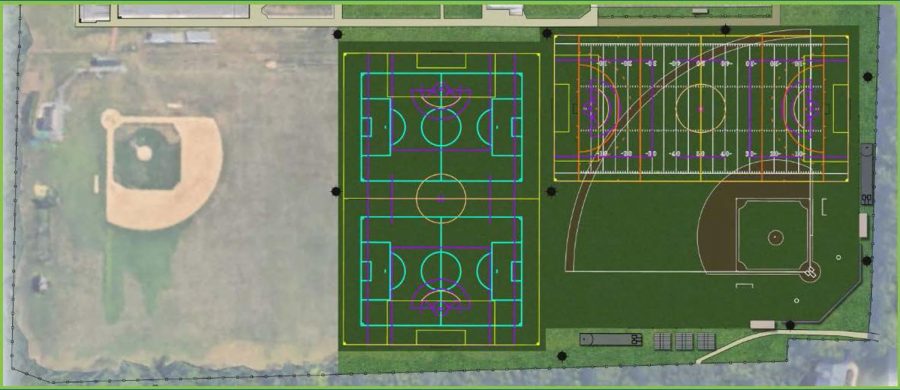Edison School Multipurpose Fields Project incites controversy
Photo courtesy of Spiezle Architectural Group
Edison School Multipurpose field project proposal
Over the past few years, there has been a constant demand for turf field time. Whether it be playing in the mud or uncut grass, traveling to other schools to avoid playing on grass or competing over the use of Sid Fay, Houlihan and Kehler fields, students and parents have been longing for more turf options. Westfield youth and high school sports have been growing rapidly, which is why the need for more fields has become a major issue for some Westfield residents.
Due to this demand, there was a $9 million Edison School Multipurpose Fields Project proposed in June. Since then, there have been three meetings which have been controversial, according to some residents. The plan that has been presented is to redo 60 percent of EIS’ back field to include one grass baseball field, two turf multipurpose fields (with lights), a turf baseball field and restroom facilities. The other 40 percent of the field would remain natural grass.
Many residents are opposed to the project including a Westfield group called Citizens for Responsible Athletic Field Development (CRAFD). They are in support of improving the fields behind EIS, but believe that improving natural grass fields to accommodate athletes is safer and more environmentally-friendly than replacing them with turf fields. They feel that there should not be any lights so peace and quiet can remain in surrounding neighborhoods. Additionally, they think that turf fields do not coincide with what Westfield students are learning in school regarding climate change and sustainability.
In an interview with His Eye, CRAFD member Jean Lemberg spoke strongly on this topic in reference to safehealthyplayingfields.org. “The use of synthetic turf is in direct opposition to what the world’s climate scientists are recommending.” Lemberg continued, “The manufacturing, installation, service and disposal of synthetic turf fields generates carbon dioxide, in addition to other greenhouse gases and pollutants which have been linked to rising global temperatures.”
Another important factor of the project is the financial aspect. Ward 3 Councilman David Contract said, “I definitely support investing in our town’s fields and infrastructure, but we have to make sure it’s well-researched and fiscally sound. This is another reason why I’m advocating for more exploration to make sure that whatever investment this town makes is a smart one and yields the best ‘bang for the taxpayer’s buck.’”
Though some are concerned about the new project at EIS, others feel that it is a necessary improvement for Westfield athletes. EIS Physical Education Teacher and Field Hockey Coach Corinne Varhley said, “I think that adding additional turf fields is absolutely necessary. As a high school coach and [adviser of] youth programs, securing turf availability in town is next to impossible. Playing field hockey on grass is not ideal and having the additional turf fields would greatly benefit my program as well as others in town.”
Not only would the project benefit teams, but it would also grant more space for physical education classes. “[The new turf fields have] so much potential to benefit young athletes and students of all ages, from P.E., to recess and athletics,” said Varhley.
Many athletes who play on the current EIS fields complain about the conditions. WHS football captain Jack Price said, “The fields aren’t too bad at the start of the season but they get rough because we dig out the whole grass since we’re on it everyday.”
Price also brought up the injuries that he and his teammates often endure because they practice on grass: “Turf would probably be safer; I roll my ankles all the time while playing [on the grass fields].”
Although there has been controversy, Contract said that it’s normal. “The democratic process is messy, and any major changes elicit both supporters and detractors. This process is important because it helps the town arrive at the best outcome that meets the needs of the majority.”
The Fields Project is still up for discussion and the process will take time. According to Contract, the next public meeting is predicted to take place sometime in December.

